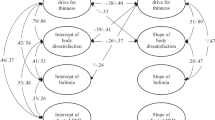Abstract
McCarthy (1990) contends that a cultural ideal of thinness (the “thin ideal”) causes depression and eating disorders to occur more frequently in women than men. She believes eating disorders are a way of coping with depression and hypothesizes that the thin ideal has its greatest impact during puberty when sexual attractiveness becomes important and changes in physical appearance increase the discrepancy between the adolescent girl's actual and ideal body image. The present study used a cross-sectional design of 5th, 8th, and 12th grade males and females (N = 599) to test several predictions from McCarthy's model. As expected, 8th and 12th grade females preferred a thinner than average body shape. They were more dissatisfied with their bodies than males and scored higher on measures of disordered eating. In contrast, before puberty (5th grade) boys were more depressed than their female peers but this pattern was reversed in 8th grade boys and girls. Paralleling changes in depression, disordered eating scores were highest in 8th and 12th grade girls. Both of these findings underscore the role of maturational factors in the onset of eating disorders. Although the sample was ethnically diverse and mainly from middle and low socioeconomic groups, there was a surprisingly high incidence of body dissatisfaction and symptoms of disordered eating. This illustrates the pervasiveness of thinness as a standard of feminine beauty in our society and the damaging effects it can have.
Similar content being viewed by others
References
American Psychiatric Association. (1987).Diagnostic and statistical manual of mental disorders (3rd rev. ed.). Washington DC: Author.
Brownell, K., & Wadden, T. (1992). Etiology and treatment of obesity: Understanding a serious, prevalent, and refractory disorder.Journal of Clinical and Consulting Psychology, 60 505–517.
Childress, A. C., Jarrell, M. P., & Brewerton, T. D. (1991).The Kid's Eating Disorders Survey (KEDS): Internal consistency, component analysis, and reliability. unpublished manuscript, Medical University of South Carolina, Department of Psychiatry and Behavioral Sciences, Charleston, SC.
Conoley, J. C., & Kramer, J. J. (1989).The tenth mental measurement yearbook. Lincoln: University of Nebraska Press.
Garner, D. M., & Garfinkel, P. E. (1980). Socio-cultural factors in the development of anorexia nervosa.Psychological Medicine, 10 647–657.
Garner, D. M., Olmstead, M. P., & Polivy, J. (1983). Development and validation of a multidimensional eating disorder inventory for anorexia nervosa and bulimia.International Journal of Eating Disorders, 2 15–34.
Garner, D. M., Rockert, W., Olmsted, M., Johnson, C., & Coscina, D. (1985). Psychoeducational principles in the treatment of bulimia and anorexia nervosa. In D. M. Garner & P. E. Garfinkel (Eds.),Handbook of psychotherapy for anorexia nervosa and bulimia (pp. 513–572). New York: Guilford Press.
Halmi, K. A., Ekert, E., LaDu, T. J., & Cohen, J. (1986). Treatment efficacy of cyproheptadine and amitriptyline.Archives of General Psychiatry, 43 177–181.
Herzog, D. B. (1984). Are anorexic and bulimic patients depressed?American Journal of Psychiatry, 141 1594–1597.
holland, A. J., Hall, A., Murray, R., Russell, G. F. M., & Crisp, A. H. (1984). Anorexia nervosa: A study of 34 twin pairs and one set of triplets.British Journal of Psychiatry, 145 414–419.
Jones, D. J., Fox, N. M., Babigan, N. M., & Hutton, H. E. (1980). Epidemiology of anorexia nervosa in Monroe County, New York: 1960–1976.Psychosomatic Medicine, 42 551–558.
Kovacs, M. (1985). The children's depression inventory (CDI).Psychopharmacology Bulletin, 21 995–998.
Kovacs, M., & Beck, A. T. (1977). An empirical-clinical approach towards a definition of childhood depression. In J. G. Schulterbrandt & A. Raskin (Eds.).Depression in childhood: Diagnosis treatment and conceptual models (pp. 1–25). New York: Raven Press.
McCarthy, M. (1990). The thin ideal, depression, and eating disorders in women.Behavior Research and Therapy, 28 205–215.
Mitchell, J., & Eckert, E. (1987). Scope and significance of eating disorders.Journal of Consulting and Clinical Psychology, 55 628–634.
Nolen-Hoeksema, S. (1987). Sex differences in unipolar depression: Evidence and theory.Psychological Bulletin, 101 259–282.
Petersen, A. C., Schulenberg, J. E., Abramowitz, R. H., Offer, D., & Jarcho, H. D. (1984). A self-image questionnaire for young adolescents: Reliability and validity studies.journal of Youth and Adolescence, 13 93–111.
Streigel-Moore, R. H., Silberstein, L. R., & Rodin, R. (1986). Towards an understanding of risk factors for bulimia.American Psychologist, 41 246–263.
Weltzin, T., Gwirtsman, H., Jimerson, D. & Kaye, W. (1990). Pharmacatherapy. In A. Bellack & M. Hersen (Eds.)Handbook of comparative treatments for adult disorders (pp. 371–388). New York: John Wiley.
Author information
Authors and Affiliations
Rights and permissions
About this article
Cite this article
Adams, P.J., Katz, R.C., Beauchamp, K. et al. Body dissatisfaction, eating disorders, and depression: A developmental perspective. J Child Fam Stud 2, 37–46 (1993). https://doi.org/10.1007/BF01321299
Issue Date:
DOI: https://doi.org/10.1007/BF01321299




